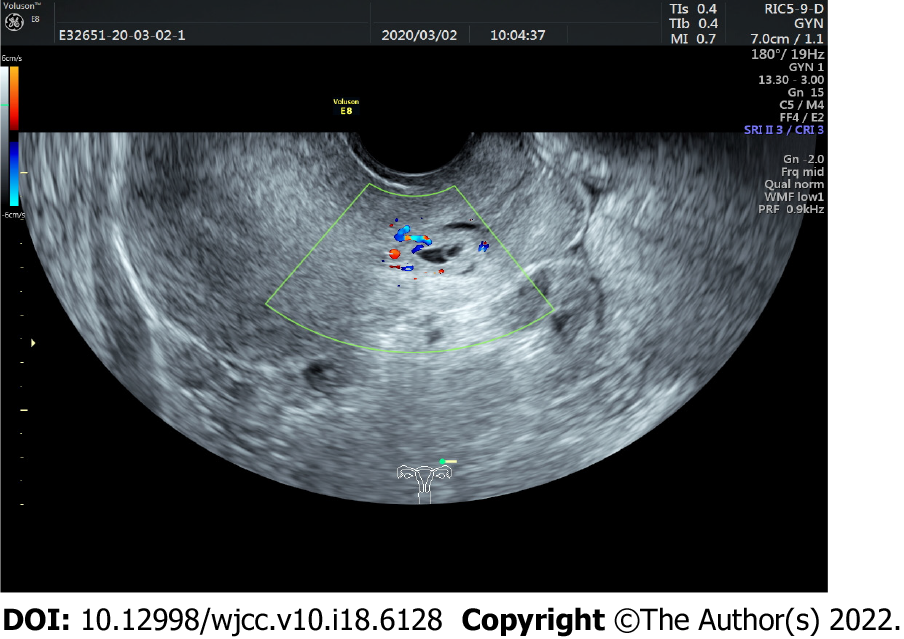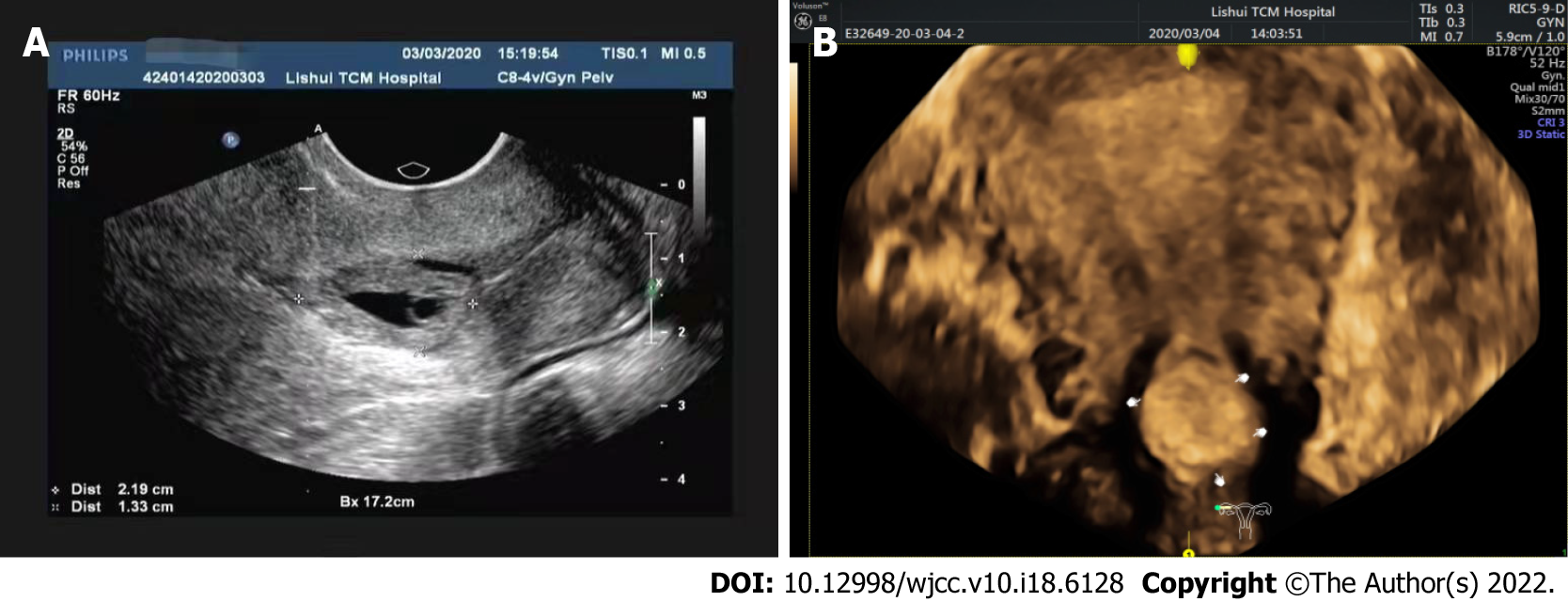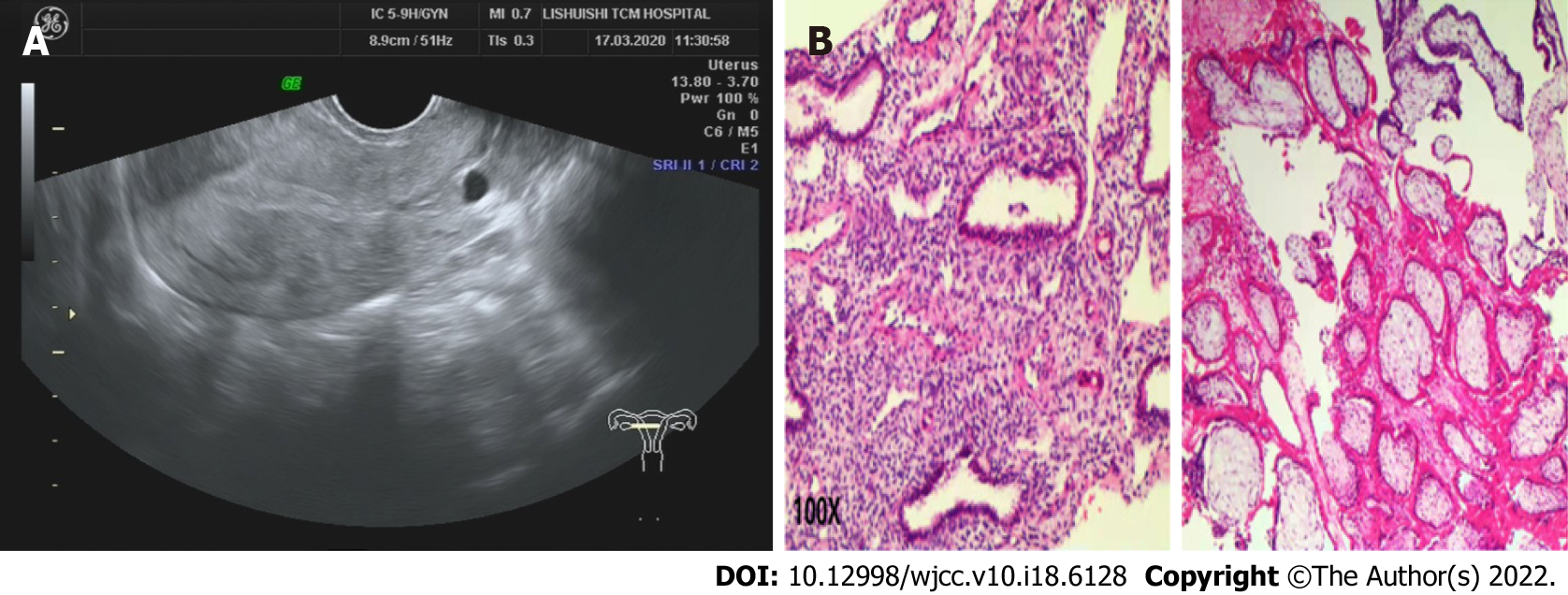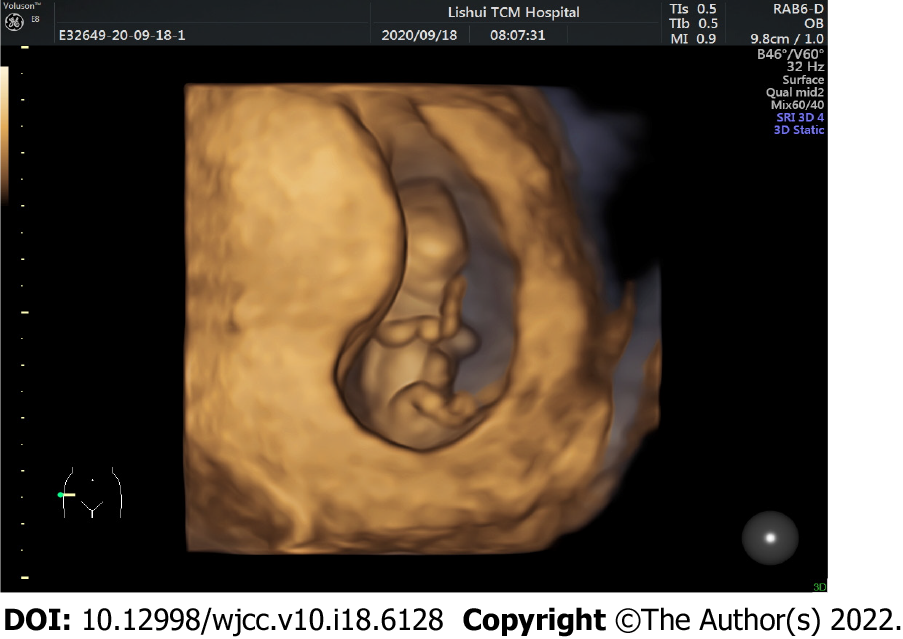Published online Jun 26, 2022. doi: 10.12998/wjcc.v10.i18.6128
Peer-review started: November 3, 2021
First decision: February 21, 2022
Revised: February 23, 2022
Accepted: April 20, 2022
Article in press: April 20, 2022
Published online: June 26, 2022
Processing time: 225 Days and 12.7 Hours
Cervical pregnancy is increasing in morbidity, and a definite diagnosis in early stages is challenging due to its specific onset site. Surgery is the mainstay of treatment for cervical pregnancy, but it may result in the loss of natural fertility. Therefore, it is a great challenge to pursue a safe and effective treatment for cervical pregnancy.
We report the case of a cervical pregnancy successfully treated by ultrasound-guided cervical-intramuscular lauromacrogol injection combined with hysteroscopy. A 23-year-old woman with minor irregular vaginal bleeding was admitted to our department with suspected ectopic pregnancy. Transvaginal ultrasound revealed a gestational sac (approximately 22 mm x 13 mm) situated in the cervical canal with a yolk sac and blood flow signals. No cardiac activity was detected. Serum beta progesterone was 17.06 ng/mL, and serum beta human chorionic gonadotropin (β-HCG) was 5077.0 IU/L. The patient was diagnosed with cervical pregnancy. She was treated by ultrasound-guided cervical-intramuscular injections of lauromacrogol (3 mL) in combination with aborting under hysteroscopic visualization. A gradual decrease in β-HCG levels and normal ultrasound findings were observed. Postoperative pathologic examination showed the presence of villi and changes in the endometrium in the secretory phase. The patient was discharged on day 6, and her β-HCG level was 0.67 mIU/mL after 1 wk. There was no statistical difference between baseline and 1-week postoperative data in terms of serum indices including liver function, renal function, and routine blood analysis after treatment. The patient subsequently became pregnant 2 mo later and no abnormalities were detected on routine screening during pregnancy.
Ultrasound-guided cervical-intramuscular lauromacrogol injection combined with hysteroscopy may be effective and safe in the treatment of cervical pregnancy.
Core Tip: This study reports a typical clinical case of cervical pregnancy who received a conservative treatment combining ultrasound-guided lauromacrogol injection with hysteroscopy. The effectiveness and safety of the conservative treatment were evaluated, and the patient obtained a good outcome.
- Citation: Ye JP, Gao Y, Lu LW, Ye YJ. Effectiveness and safety of ultrasound-guided intramuscular lauromacrogol injection combined with hysteroscopy in cervical pregnancy treatment: A case report. World J Clin Cases 2022; 10(18): 6128-6135
- URL: https://www.wjgnet.com/2307-8960/full/v10/i18/6128.htm
- DOI: https://dx.doi.org/10.12998/wjcc.v10.i18.6128
Cervical pregnancy is a type of ectopic pregnancy associated with induced abortion, diagnostic curettage, cesarean section, spontaneous abortion, cervical surgery, and assisted reproductive technology[1,2]. It results in increased morbidity and is diagnosed in around 0.15% of all ectopic pregnancies[3]. A definite diagnosis in the early stages is challenging due to the specific onset site. It is commonly diagnosed by ultrasound because of vaginal bleeding[4], and is often accompanied by critical medical conditions. Surgery is the mainstay in the conventional management of cervical pregnancy, but tends to cause cervical adhesions and decreased function, resulting in the loss of natural fecundity. With significant advances in clinical diagnostic techniques and a growing demand for fertility, non-invasive or minimally invasive surgery has attracted increasing attention[5]. Currently, conservative treatment combining a local injection of methotrexate (MTX) or potassium chloride, oral mifepristone, and hysteroscopy is commonly used for cervical pregnancy with good efficacy[6-9]. However, high drug doses may induce damage to liver and renal function, as well as female fertility. In this context, it is challenging to develop a conservative treatment with a good safety profile[10].
Here, we report a typical case of cervical pregnancy treated by ultrasound-guided lauromacrogol injection combined with hysteroscopy. The effectiveness and safety were evaluated and the patient had a good outcome.
The patient was 23 years old. She previously had five pregnancies and five abortions, including one ectopic pregnancy. She had menopause for 39 d and a little irregular vaginal bleeding for 10 d, and the last menstruation was recorded on January 23, 2020. She visited our hospital on March 2, 2020 due to similar symptoms. Her serum beta progesterone (P) was 17.06 ng/mL, and beta human chorionic gonadotropin (β-HCG) was 5077.0 IU/L. The patient was diagnosed with cervical pregnancy by transvaginal ultrasound (Figure 1) and was hospitalized.
The patient had menopause for 39 d and a little irregular vaginal bleeding for 10 d, and the last menstruation was recorded on January 23, 2020.
The patient had five intrauterine pregnancies including one tubal ectopic pregnancy, but no delivery.
There was no abnormality in personal and family history.
Physical examination showed that the patient’s blood pressure was 122/83 mmHg, pulse rate was 89 bpm, temperature was 37.4℃, and respiratory rate was 20 breaths/min. Obstetrical examination findings included non-vaginal delivery, smooth vagina, slight bleeding, smooth and full cervix with no pain when held, severe uterine anteversion without tenderness, and normal bilateral fallopian tubes and ovaries.
Serum beta progesterone was 17.06 ng/mL, and β-HCG was 5077.0 IU/L.
B-ultrasound was scheduled for the following day, and a gestational sac (approximately 22 mm x 13 mm) was situated in the cervical canal with a yolk sac and blood flow signals inside. In the meantime transvaginal ultrasound-guided tunnel puncture was thus arranged after routine disinfection using a 21G-EV type needle. Approximately 2 mL of fluid was obtained from the mass. Multiple lauromacrogol injections (3 mL) were performed targeting the cystic wall and cavity (Figure 2A). No pain or bleeding at the puncture area was observed during and after treatment. The patient was then transferred to the ward. Postoperative uterine three-dimensional B-ultrasound revealed the absence of blood flow signals around the gestational sac (Figure 2B).
The patient was diagnosed with cervical pregnancy.
At 15:09 on March 4, aborting under hysteroscopic visualization was performed under general anesthesia with intubation. A villous tissue block (approximately 1 cm x 1.5 cm) was present and removed (around 8 g) after intramuscular injection of 3 U of pitavastatin and 1 wk with a suction tube. Further hysteroscopy revealed a rough cervical canal with a little bleeding, and balloon compression for hemostasis was provided. The procedure was uneventful and the intraoperative blood loss was approximately 50 mL. On March 5, no abnormalities were observed on B-ultrasound (Figure 3A). β-HCG was 2049.0 IU/L on March 6, 1213.0 IU/L on March 7, 496.6 IU/L on March 9, and 0.68 IU/L on March 17. No abnormalities were detected in the uterine cavity on transvaginal ultrasound on March 6, and postoperative pathologic examination on March 17 showed the presence of villi and changes in the endometrium in the secretory phase (Figure 3B).
In addition, there were no significant differences between baseline and 1-wk postoperative data with regard to serum indices including liver function, renal function, and routine blood analysis (Table 1).
| Before | One week after | |
| Hemoglobin (g/L) | 126 | 124 |
| White blood cell count (× 109/L) | 4.2 | 3.9 |
| Platelet count (× 109/L) | 167 | 184 |
| Alanine aminotransferase (U/L) | 11 | 18 |
| Aspartate aminotransferase (U/L) | 19 | 16 |
| Creatinine (μmol/L) | 49 | 42 |
| Urea nitrogen (mmol/L) | 3 | 2.6 |
| Uric acid (μmol/L) | 183 | 180 |
During the follow-up period, the patient had normal menstruation on April 12, with a normal volume and color, which finished within 5 d (Table 2).
| Before (September 9, 2019) | After (May 8, 2020) | |
| Follicle-stimulating hormone (mIU/mL) | 5.53 | 5.89 |
| Luteinizing hormone (mIU/mL) | 4.16 | 6.37 |
| Progesterone (ng/mL) | 0.28 | 0.26 |
| Testosterone (nmol/L) | 1.28 | 1.34 |
| Prolactin (ng/mL) | 26.23 | 45.59 |
| Estradiol (pmol/L) | 121.9 | 292.3 |
| Endometriosis (mm) | 6 | 7 |
| Antral follicle count (n) | 7 | 6 |
There were 5-7 antral follicles in the left ovary and 6-8 follicles in the right ovary. The endometrium was 11 mm thick on the 15th day of menstruation. On September 18, 2020 (day 79 of subsequent pregnancy), nuchal translucency examination suggested normal fetal development (Figure 4). No abnormalities were observed on routine screening during pregnancy. A live healthy infant was delivered on April 8, 2021.
Reproductive hormones, antral follicle count, and the endometrium all recovered to normal values, and no impairment of liver and renal function was observed after treatment. These findings indicate that lauromacrogol injection combined with hysteroscopy is effective and safe in the treatment of cervical pregnancy, and does not have adverse effects on fertility. Gestational and postnatal examinations showed subsequent normal fetal development. Thus, no short-term adverse effects were observed following this treatment strategy and subsequent pregnancy can be expected.
Cervical pregnancy is mainly composed of fibrous connective tissue. It can cause compromised cervical contractions and a high risk of extensive bleeding[11]. If inappropriately managed, the outcome can be catastrophic. Conventional treatment mainly includes hysterectomy. With improvements in clinical diagnostic techniques and an increasing demand for fertility, non-invasive or minimally invasive surgery is preferred by both doctors and families. Therefore, the hysterectomy rate significantly decreased from 89.5% in 1979 to 21.7% in 1994[12]. Conservative treatments mainly include MTX + curettage + interventional embolization + mifepristone or potassium chloride, local injection of vasoconstrictor, ligation of the uterus, blood vessels, and internal iliac artery, cervical cerclage, cervical Foley tube tamponade, electrosurgical excision, and radiofrequency ablation[10,13-15]. However, the safety of conservative treatment has been less studied. MTX and mifepristone are commonly used drugs with definite efficacy in the treatment of cervical pregnancy. However, in the context of a high dose, patients can develop nausea, vomiting, or impaired liver and renal function, in addition to unpredictable fertility. It was reported that a minimum 3 mo interval after MTX application is required for a subsequent pregnancy[16].
Lauromacrogol is a novel vascular sclerosant harboring hydrophilic and lyophilic groups, which conform to a directional alignment on a liquid surface to allow a significant decline in surface tension. It is important in sclerotherapy, as it can cause sterile inflammation with the groups which can help obtain protein precipitation in several seconds and thus cause damage to the lipid bilayer of the cell membrane, thereby leading to fibrous tissue hyperplasia and adhesions[17,18]. In addition, it has great applications in digestive, cardiovascular, and nervous system diseases[19,20]. However, there is a paucity of reports on lauromacrogol as a hemostatic agent in ectopic pregnancy. Wei et al[21] previously adopted ultrasound-guided local lauromacrogol injection plus suction curettage in the treatment of type II cesarean scar pregnancy with a favorable therapeutic outcome, but the safety of lauromacrogol was not evaluated.
Our patient had five intrauterine pregnancies including one tubal ectopic pregnancy, but no delivery. Considering the strong will of the patient and her family for fertility preservation, an attempt was made to decrease the blood supply in the gestational sac using local injections of lauromacrogol, instead of uterine artery embolization, combined with ultrasound-guided intervention. It has been established that lauromacrogol can block the blood circulation of the embryo and cervical vein without interfering with the blood supply to the ovary. The sclerosis and hemostasis induced by lauromacrogol are mainly realized in the following two ways: Vascular lauromacrogol injection can cause direct damage to vascular endothelial cells in attached veins at the site of injection, allowing local thrombosis, the formation of a protective layer for fibrous tissue surrounding the ruptured vessels, and an increase in vascular resistance. In that way, hemostasis can be obtained by regional vascular compression contributing to decreased blood flow. In addition, lauromacrogol injection can cause superficial small areas of fibrosis in veins around the injection site, resulting in vascular compression and occlusion[22]. Here, B-ultrasound 24 h after lauromacrogol injection showed no blood supply to the gestational sac. Hysteroscopic curettage was instantly performed with a little intraoperative bleeding. This suggested the favorable vascular stiffening and rapid onset of action (3-24 h) of lauromacrogol, which greatly decreased intraoperative bleeding, shortened the time to curettage, and increased the success rate[23]. Lauromacrogol is also a type of local anesthetic that can achieve local analgesia and alleviate discomfort in patients during treatment. Polycinol injection combined with uterine curettage under ultrasound intervention for cesarean scar pregnancy has no significant effect on endometrial thickness and scar thickness in patients. After the operation, the blood supply to the uterine scar recovers well, and the menstrual recovery time is significantly shorter than that following MTX treatment. In addition, the fertility of patients can be well preserved[24].
Liver and renal function in our patient were also evaluated and showed no difference before and after treatment. Consistent with the existing literature, lauromacrogol had no adverse effects on the liver and kidneys. Similar results were observed for reproductive hormones, ovarian volume, antral follicle count, and the endometrium, resulting in a well preserved uterus and ovarian physiological functions. The patient had normal menstruation 40 d after treatment. She conceived naturally after 2 mo with normal fetal development (Figure 4) and successful delivery.
The present case demonstrated the effectiveness and safety of lauromacrogol injection plus hysteroscopy in the treatment of cervical pregnancy, which had no adverse effects on liver and renal function, fertility, and fetal development following subsequent conception. This treatment strategy deserves to be promoted and applied in the clinic. Lauromacrogol, a sclerosant used to treat cystic disease or vascular disease, has certain adverse reactions, such as low-grade fever, local pain, venous embolism, and anaphylactic reaction, most of which are mild and self-limited. However, there is a risk of serious adverse reactions during the treatment of venous disease, and the occurrence of adverse heart events should be prevented[25]. Further research on clinical indications, contraindications, and its potential as a replacement for conventional hemostatic agents and blasticidin is necessary.
Provenance and peer review: Unsolicited article; Externally peer reviewed.
Peer-review model: Single blind
Specialty type: Obstetrics and gynecology
Country/Territory of origin: China
Peer-review report’s scientific quality classification
Grade A (Excellent): 0
Grade B (Very good): 0
Grade C (Good): C, C, C
Grade D (Fair): 0
Grade E (Poor): 0
P-Reviewer: Karavaş E, Turkey; Okasha H, Egypt; Socea B, Romania S-Editor: Ma YJ L-Editor: Wang TQ P-Editor: Ma YJ
| 1. | Hoyos LR, Tamakuwala S, Rambhatla A, Brar H, Vilchez G, Allsworth J, Rodriguez-Kovacs J, Awonuga A. Risk factors for cervical ectopic pregnancy. J Gynecol Obstet Hum Reprod. 2019;101665. [RCA] [PubMed] [DOI] [Full Text] [Cited by in Crossref: 4] [Cited by in RCA: 7] [Article Influence: 1.2] [Reference Citation Analysis (0)] |
| 2. | Dziedzic JM, Patel PV. Cervical Ectopic Pregnancy: A Rare Site of Implantation. J Emerg Med. 2019;56:e123-e125. [RCA] [PubMed] [DOI] [Full Text] [Cited by in Crossref: 5] [Cited by in RCA: 7] [Article Influence: 1.2] [Reference Citation Analysis (0)] |
| 3. | Hirakawa M, Tajima T, Yoshimitsu K, Irie H, Ishigami K, Yahata H, Wake N, Honda H. Uterine artery embolization along with the administration of methotrexate for cervical ectopic pregnancy: technical and clinical outcomes. AJR Am J Roentgenol. 2009;192:1601-1607. [RCA] [PubMed] [DOI] [Full Text] [Cited by in Crossref: 38] [Cited by in RCA: 40] [Article Influence: 2.5] [Reference Citation Analysis (0)] |
| 4. | Chen YZZ, Zhou JY. Effect of transabdomen ultrasound and transvaginal ultrasonography for diagnosing cervical ectopic pregnancy. Zhongguo Jihua Shengyuxue Zazhi. 2020;28:1621-1623+1724. |
| 5. | Han JY, Kim H, Kim SW, Ku SY, Suh CS, Kim SH. Use of haemostatic gel in the management of cervical pregnancy: a case report. Eur J Contracept Reprod Health Care. 2021;26:167-170. [RCA] [PubMed] [DOI] [Full Text] [Cited by in Crossref: 3] [Cited by in RCA: 2] [Article Influence: 0.5] [Reference Citation Analysis (0)] |
| 6. | De La Vega GA, Avery C, Nemiroff R, Marchiano D. Treatment of early cervical pregnancy with cerclage, carboprost, curettage, and balloon tamponade. Obstet Gynecol. 2007;109:505-507. [RCA] [PubMed] [DOI] [Full Text] [Cited by in Crossref: 30] [Cited by in RCA: 31] [Article Influence: 1.7] [Reference Citation Analysis (0)] |
| 7. | Oliver R, Malik M, Coker A, Morris J. Management of extra-tubal and rare ectopic pregnancies: case series and review of current literature. Arch Gynecol Obstet. 2007;276:125-131. [RCA] [PubMed] [DOI] [Full Text] [Cited by in Crossref: 32] [Cited by in RCA: 21] [Article Influence: 1.2] [Reference Citation Analysis (0)] |
| 8. | Verma U, Goharkhay N. Conservative management of cervical ectopic pregnancy. Fertil Steril. 2009;91:671-674. [RCA] [PubMed] [DOI] [Full Text] [Cited by in Crossref: 59] [Cited by in RCA: 62] [Article Influence: 3.9] [Reference Citation Analysis (0)] |
| 9. | Petousis S, Margioula-Siarkou C, Kalogiannidis I, Karavas G, Palapelas V, Prapas N, Rousso D. Conservative management of cervical pregnancy with intramuscular administration of methotrexate and KCl injection: Case report and review of the literature. World J Clin Cases. 2015;3:81-84. [RCA] [PubMed] [DOI] [Full Text] [Full Text (PDF)] [Cited by in CrossRef: 9] [Cited by in RCA: 9] [Article Influence: 0.9] [Reference Citation Analysis (0)] |
| 10. | Singh S. Diagnosis and management of cervical ectopic pregnancy. J Hum Reprod Sci. 2013;6:273-276. [RCA] [PubMed] [DOI] [Full Text] [Full Text (PDF)] [Cited by in Crossref: 21] [Cited by in RCA: 21] [Article Influence: 1.9] [Reference Citation Analysis (0)] |
| 11. | Weibel HS, Alserri A, Reinhold C, Tulandi T. Multidose methotrexate treatment of cervical pregnancy. J Obstet Gynaecol Can. 2012;34:359-362. [RCA] [PubMed] [DOI] [Full Text] [Cited by in Crossref: 15] [Cited by in RCA: 16] [Article Influence: 1.2] [Reference Citation Analysis (0)] |
| 12. | Kung FT, Chang SY. Efficacy of methotrexate treatment in viable and nonviable cervical pregnancies. Am J Obstet Gynecol. 1999;181:1438-1444. [RCA] [PubMed] [DOI] [Full Text] [Cited by in Crossref: 88] [Cited by in RCA: 77] [Article Influence: 3.0] [Reference Citation Analysis (0)] |
| 13. | Imai K, Fukushi Y, Nishimura M, Ohara Y, Suzuki Y, Ota H, Nakajima A, Wada S, Fujino T. Combination of conservative treatment and temporary bilateral laparoscopic uterine artery clipping with hysteroscopic transcervical resection for cervical pregnancy: A retrospective study. J Gynecol Obstet Hum Reprod. 2021;50:101735. [RCA] [PubMed] [DOI] [Full Text] [Cited by in Crossref: 2] [Cited by in RCA: 4] [Article Influence: 0.8] [Reference Citation Analysis (0)] |
| 14. | Jachymski T, Moczulska H, Guzowski G, Pomorski M, Piątek S, Zimmer M, Rokita W, Wielgoś M, Sieroszewski P. Conservative treatment of abnormally located intrauterine pregnancies (cervical and cesarean scar pregnancies): a multicenter analysis (Polish series). J Matern Fetal Neonatal Med. 2020;33:993-998. [RCA] [PubMed] [DOI] [Full Text] [Cited by in Crossref: 3] [Cited by in RCA: 7] [Article Influence: 1.0] [Reference Citation Analysis (0)] |
| 15. | Elmokadem AH, Abdel-Wahab RM, El-Zayadi AA, Elrakhawy MM. Uterine Artery Embolization and Methotrexate Infusion as Sole Management for Caesarean Scar and Cervical Ectopic Pregnancies: A Single-Center Experience and Literature Review. Can Assoc Radiol J. 2019;70:307-316. [RCA] [PubMed] [DOI] [Full Text] [Cited by in Crossref: 14] [Cited by in RCA: 16] [Article Influence: 2.7] [Reference Citation Analysis (0)] |
| 16. | Hackmon R, Sakaguchi S, Koren G. Effect of methotrexate treatment of ectopic pregnancy on subsequent pregnancy. Can Fam Physician. 2011;57:37-39. [RCA] [PubMed] [DOI] [Full Text] [Full Text (PDF)] [Cited by in Crossref: 11] [Cited by in RCA: 10] [Article Influence: 0.7] [Reference Citation Analysis (0)] |
| 17. | Kitagawa A, Yamamoto T, Matsunaga N, Yamaji M, Ikeda S, Izumi Y, Hagihara M, Ota T, Ishiguchi T. Polidocanol Sclerotherapy Combined with Transarterial Embolization Using n-Butyl Cyanoacrylate for Extracranial Arteriovenous Malformations. Cardiovasc Intervent Radiol. 2018;41:856-866. [RCA] [PubMed] [DOI] [Full Text] [Full Text (PDF)] [Cited by in Crossref: 11] [Cited by in RCA: 12] [Article Influence: 1.7] [Reference Citation Analysis (0)] |
| 18. | Gatz M, Schrading S, Dirrichs T, Betsch M, Tingart M, Rath B, Kuhl C, Quack V. Topical polidocanol application in combination with static stretching in tendinopathies: a prospective pilot study. Muscles Ligaments Tendons J. 2017;7:88-97. [RCA] [PubMed] [DOI] [Full Text] [Cited by in Crossref: 10] [Cited by in RCA: 11] [Article Influence: 1.4] [Reference Citation Analysis (0)] |
| 19. | Ramadani A, Jovanovska RP, Trajkovska M, Andreevski V, Calovska V, Serafimoski V, Bojadzieva S. Comparison of Argon Plasma Coagulation and Injection Therapy with Adrenalin and Polidocanol in the Management of Bleeding Angiodysplasia in Upper Gastrointestinal Tract. Pril (Makedon Akad Nauk Umet Odd Med Nauki). 2018;39:63-68. [RCA] [PubMed] [DOI] [Full Text] [Cited by in Crossref: 2] [Cited by in RCA: 2] [Article Influence: 0.3] [Reference Citation Analysis (0)] |
| 20. | Gupta G, Pandit RS, Jerath N, Narasimhan R. Severe life-threatening hypersensitivity reaction to polidocanol in a case of recurrent aneurysmal bone cyst. J Clin Orthop Trauma. 2019;10:414-417. [RCA] [PubMed] [DOI] [Full Text] [Cited by in Crossref: 10] [Cited by in RCA: 10] [Article Influence: 1.7] [Reference Citation Analysis (0)] |
| 21. | Wei SS, Li DH, Zhang ZF, Sun WC, Jia CL. Type II caesarean scar pregnancy management by ultrasound-guided local lauromacrogol injection in combination with suction curettage: A case report. Medicine (Baltimore). 2020;99:e19743. [RCA] [PubMed] [DOI] [Full Text] [Full Text (PDF)] [Cited by in Crossref: 2] [Cited by in RCA: 1] [Article Influence: 0.2] [Reference Citation Analysis (0)] |
| 22. | Chai ZY, Yu L, Liu MM, Zhu TW, Qi F. Evaluation of the Efficacy of Ultrasound-Guided Local Lauromacrogol Injection Combined with Aspiration for Cesarean Scar Pregnancy: A Novel Treatment. Gynecol Obstet Invest. 2018;83:306-312. [RCA] [PubMed] [DOI] [Full Text] [Cited by in Crossref: 9] [Cited by in RCA: 13] [Article Influence: 1.6] [Reference Citation Analysis (0)] |
| 23. | Dong JJ, Chen MZ, Yu L, Han WS. Effect of lauromacrogol combined with curettage on ulterine scar pregnancy after cesareansection. Zhongguo Fuyou Jiankang Yanjiu. 2018;29:1331-1334. |
| 24. | Sun Y, Wei FB, Wei HJ, Liu ZN, Qiu D. Observation of long-term efficacy of polidocanol injection combined with uterine curettage in the treatment of cesarean scar pregnancy under ultrasound intervention. Zhongguo Shiyong Yiyao. 2020;15:18-20. [DOI] [Full Text] |
| 25. | Qin YL, Zhou J. Clinical application and adverse reactions of Lauromacrogol. Zhongguo Jieru Yingxiang Yu Zhiliaoxue. 2020;17:569-572. [DOI] [Full Text] |












